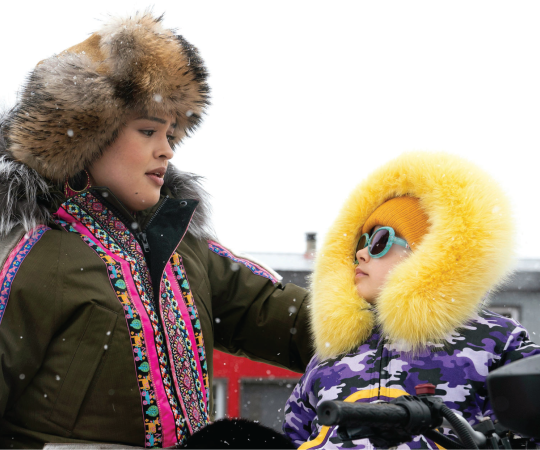Jeela Palluq-Cloutier sat at her dining table in Iqaluit, staring at her aging MacBook Air. One side of her laptop screen listed English sentences, while the other featured Inuktitut and Inuinnaqtun translations. She rated each sentence for accuracy from zero to 100 per cent. “War in Afghanistan” became “pandemic outbreak in Arviat.” Zero. “Prime rib” became “prime minister.” Zero. Some text about housing in Nunavut mentioned single units, apartment buildings and then—usuup puunga. Condom. Huh? Palluq-Cloutier looked over to the English side of her screen. Condo! “That’s the funniest one I came across,” she says.
The Nunavut government had hired the translator and teacher from Igloolik when Microsoft planned to add Inuktitut and Inuinnaqtun text to its Translator app in 2022. Artificial intelligence would do the bulk of the work, but first Microsoft had to teach it 20 million words by feeding it reams of public documents. This meant the AI was well versed in bureaucratic lingo, but less so in international affairs and fine dining. Palluq-Cloutier’s role was to check the accuracy of its translations.
Late last year, when Microsoft announced the app’s ability to read translated Inuktitut text aloud—in a male voice named Taqqiq or a female one named Siqiniq—Palluq-Cloutier was one of the Nunavummiut behind that advancement as well. Microsoft isn’t alone. Two months earlier, Google Translate had added Inuktut text-to-text translations, in collaboration with Inuit Tapiriit Kanatami. These developments have opened up communication within families, classrooms and workplaces.
Inuktitut joined the online world in the 1980s and ’ 90s, as computers became more commonplace. Needing words for modern terms, Inuit language experts chose qarasaujaq, meaning “like that of a brain,” for computer. Mouse became avinngannguaq, or “fake lemming.” And for the internet, they picked ikiaqqijjut, which means “the tool to travel through the layers” and, traditionally, refers to shamans who could travel spiritually all over the world. Not a bad way to put it.
AI is well-suited to translation because of the repeating patterns in languages. To develop Inuktitut text-to-speech, Microsoft gathered hours of audio and transcriptions from fluent speakers. But someone needed to check that no accidental “condoms” snuck in. By this time, Palluq-Cloutier and her husband, Stéphane Cloutier, the former Nunavut director of official languages, had moved to Ste-Perpetue-de-L’Islet, Que. Her office was now in their third bedroom, and she’d replaced her old MacBook (RIP) with a new computer. Together, she and Cloutier sifted through all the transcripts to make sure they matched the audio and used standard spelling of Inuktitut words.
Palluq-Cloutier first worked with Microsoft in the early 2000s, translating its user interface into Inuktitut. She’s now a celebrity in the world of language experts, though she modestly disputes that. “I have had some involvement,” she says. When Nunatsiaq News ran an article about the language coming to Facebook, two readers commented that Palluq-Cloutier needed to be credited for the job. A week later, the paper published a feature about her. In 2022, Nunavut Premier P.J. Akeeagok presented her with a national award recognizing her language-revitalization work.
She’s also received less-official praise. A man approached Palluq-Cloutier at an Iqaluit restaurant to tell her he was using Microsoft Translator every day at work. A woman told her she’d shown the app to an Inuk resident at an Ottawa retirement home, and the senior was thrilled to be able to understand English street signs.
Palluq-Cloutier has found it useful, too. At a dental office in Quebec, as she prepared for a tooth extraction, Stéphane snapped a photo of the after-care information and then Microsoft Translator immediately transformed the French into Inuktitut. She understood it perfectly. “I was like, ‘Holy shit, man,’” she says. In other words, 100 per cent.









